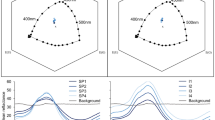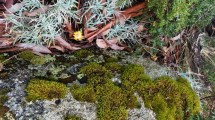Abstract
It has long been assumed that bees cannot see red. However, bees visit red flowers, and the visual spectral sensitivity of bees extends into wavelengths to provide sensitivity to such flowers. We thus investigated whether bees can discriminate stimuli reflecting wavelengths above 560 nm, i.e., which appear orange and red to a human observer. Flowers do not reflect monochromatic (single wavelength) light; specifically orange and red flowers have reflectance patterns which are step functions, we thus used colored stimuli with such reflectance patterns. We first conditioned honey bees Apis mellifera to detect six stimuli reflecting light mostly above 560 nm and found that bees learned to detect only stimuli which were perceptually very different from a bee achromatic background. In a second experiment we conditioned bees to discriminate stimuli from a salient, negative (un-rewarded) yellow stimulus. In subsequent unrewarded tests we presented the bees with the trained situation and with five other tests in which the trained stimulus was presented against a novel one. We found that bees learned to discriminate the positive from the negative stimulus, and could unambiguously discriminate eight out of fifteen stimulus pairs. The performance of bees was positively correlated with differences between the trained and the novel stimulus in the receptor contrast for the long-wavelength bee photoreceptor and in the color distance (calculated using two models of the honeybee colors space). We found that the differential conditioning resulted in a concurrent inhibitory conditioning of the negative stimulus, which might have improved discrimination of stimuli which are perceptually similar. These results show that bees can detect long wavelength stimuli which appear reddish to a human observer. The mechanisms underlying discrimination of these stimuli are discussed.





Similar content being viewed by others
References
Backhaus W (1991) Color opponent coding in the visual system of the honeybee. Vision Res 31:1381–1397
Briscoe AD, Chittka L (2001) The evolution of color vision in insects. Ann Rev Entomol 46:471–510
Chittka L (1992) The colour hexagon: a chromacity diagram based on excitations as a generalized representation of colour opponency. J Comp Physiol A 170:533–543
Chittka L, Menzel R (1992) The evolutionary adaptation of flower colours and the insect pollinators’ color vision. J Comp Physiol A 171:171–181
Chittka L, Waser NM (1997) Why red flowers are not invisible to bees. Israel J Plant Sci 45:169–183
Chittka L, Beier W, Hertel H, Steinmann E, Menzel R (1992) Opponent coding is a universal strategy to evaluate the photoreceptor inputs in Hymenoptera. J Comp Physiol A 170:545–563
Dyer AG, Chittka L (2004a) Biological significance of distinguishing between similar colours in spectrally variable illumination: bumblebees (Bombus terrestris) as a case study. J Comp Physiol A 190:105–114
Dyer AG, Chittka L (2004b) Fine colour discrimination requires differential conditioning in bumblebees. Naturwissenschaften 91:224–227
Gegenfurtner KR, Kiper DC (2003) Color vision. Ann Rev Neurosci 26:181–206
Giurfa M (2004) Conditioning procedure and color discrimination in the honeybee Apis mellifera. Naturwissenschaften 91:228–231
Giurfa M, Vorobyev M (1998) The angular range of achromatic target detection by honeybees. J Comp Physiol A 183:101–110
Giurfa M, Núñez J, Chittka L, Menzel R (1995) Colour preferences of flower-naive honeybees. J Comp Physiol A 177:247–259
Giurfa M, Vorobyev M, Kevan PG, Menzel R (1996) Detection of coloured stimuli by honeybees: minimum visual angles and receptor specific contrasts. J Comp Physiol A 178:699–709
Giurfa M, Vorobyev M, Brandt R, Posner B, Menzel R (1997) Discrimination of coloured stimuli by honeybees: alternative use of achromatic and chromatic signals. J Comp Physiol A 180:235–243
Giurfa M, Hammer M, Stach S, Stollhoff N, Müller-Deisig N, Mizyrycki C (1999) Pattern learning by honeybees: conditioning procedure and recognition strategy. Anim Behav 57:315–324
Hempel de Ibarra N, Giurfa M (2003) Discrimination of closed coloured shpaes by honeybees requires only contrast to the long wavelength receptor type. Anim Behav 66:903–910
Hempel de Ibarra N, Vorobyev M, Brandt R, Giurfa M (2000) Detection of bright and dim colours by honeybees. J Exp Biol 203:3289–3298
Kelber A, Hénique U (1999) Trichormatic colour vision in the hummingbird hawkmoth, Macroglossum stellatarum L. J Comp Physiol A 184:535–541
Kelber A, Vorobyev M, Osorio D (2003) Animal color vision––behavioural tests and physiological concepts. Biol Rev 78:81–118
Kien J, Menzel R (1977) Chromatic properties of interneurons in the optic lobes of the bee II. Narrow band and colour opponent neurons. J Comp Physiol A 113:35–53
Lehrer M (1993) Spatial vision in the honeybee: the use of different cues in different tasks. Vis Res 34:2363–2385
Lehrer M, Bischof S (1995) Detection of model flowers by honeybees: the role of chromatic and achromatic contrast. Naturwissenschaften 82:147
Lehrer M, Srinivasan M, Zhang S (1990) Visual edge detection in the honeybee and its chromatic properties. Proc Roy Soc B Biol Sci 238:321–330
Lennie P (2000) Color vision. In: Kandel ER, Schwartz JH, Jessell TM (eds) Principles of neural science. McGraw-Hill, pp 572–589
Menzel R, Backhaus W (1991) Colour vision in insects. In: Gouras P (ed) Vision and visual dysfunction. The perception of colour. MacMillan, London, pp 262–288
Peitsch D, Fietz A, Hertel H, de Souza J, Ventura DF, Menzel R (1992) The spectral input systems of hymenopteran insects and their receptor-based colour vision. J Comp Physiol A 170:23–40
Rodríguez-Gironés MA, Santamaría L (2004) Why are so many bird flowers red? Plos Biol 2:1515–1519
Skorupski P, Döring TF, Chittka L (2007) Photoreceptor spectral sensitivity in island and mainland populations of the bumblebee, Bombus terrestris. J Comp Physiol A 193:485–494
Spaethe J, Tautz J, Chittka L (2001) Visual constraints in foraging bumblebees: flower size and color affect search time and flight behavior. Proc Natl Acad Sci USA 98:3898–3903
von Frisch K (1914) Demonstration von Versuchen zum Nachweis des Farbensehens bei angeblich total farbenblinden Tieren. Verhandl Deutsch Zool Ges 24:50–58
Yang EC, Lin HC, Hung YS (2004) Patterns of chromatic information processing in the lobula of the honeybee, Apis mellifera L. J Insect Physiol 50:913–925
Zaccardi G, Kelber A, Sison-Mangus MP, Briscoe AD (2006) Color discrimination in the red range with only one long-wavelength sensitive opsin. J Exp Biol 209:1944–1955
Zar J (1999) Biostatistical analysis. Prentice-Hall Inc., Upper Saddle River
Acknowledgments
Authors are indebted to two kind anonymous reviewers and L. Chittka for their insightful and helpful comments and suggestions which greatly improved this manuscript.
Author information
Authors and Affiliations
Corresponding author
Additional information
Handling Editor: Lars Chittka.
Rights and permissions
About this article
Cite this article
Reisenman, C.E., Giurfa, M. Chromatic and achromatic stimulus discrimination of long wavelength (red) visual stimuli by the honeybee Apis mellifera . Arthropod-Plant Interactions 2, 137–146 (2008). https://doi.org/10.1007/s11829-008-9041-8
Received:
Accepted:
Published:
Issue Date:
DOI: https://doi.org/10.1007/s11829-008-9041-8




